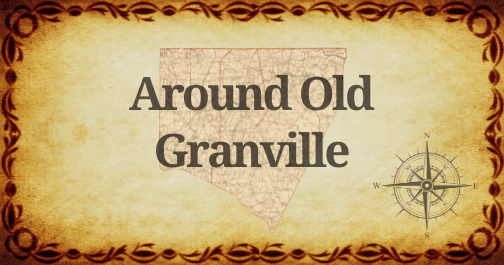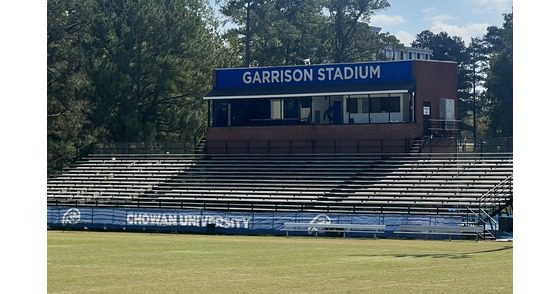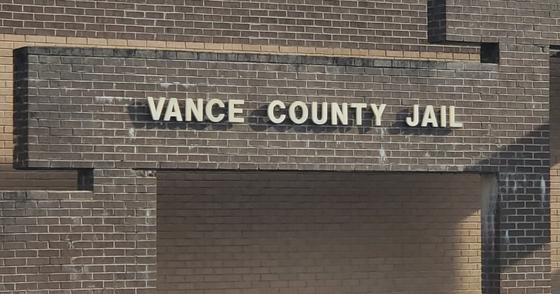Modern-day gold prospectors like Tim Fisher have tools and technology that simply weren’t available to folks who ventured to California and Alaska to make their fortunes during the era known as the Gold Rush. What Fisher undoubtedly does share with those earlier prospectors, however, is an enthusiasm and curiosity about what may lie just below the surface.
Gold. Right here in North Carolina.
Fisher was a guest on Town Talk Monday and he spoke with host Bill Harris about land he and his son own in northeast Franklin County, near the Nash County line. It once was part of the property on which the Portis Gold Mine is located, and Fisher hopes to restore the area to its former golden glory. In fact, he said he hopes to do some work in the next week or so on some dredge piles that haven’t been touched since the mine was active. What he finds, he said, he will post on another tool his prospecting predecessors didn’t have – social media.
For the audio of TownTalk click play…
Fisher runs Eastern Outdoor Expeditions and he hopes the Gold Run Branch Goldmine will be a place where people can have fun learning how to pan for gold while learning something new about an activity that spurred a frenzy in mid-19th century United States. Prospectors and miners flocked to California and then to Alaska, Fisher said, in search of their fortunes by digging in the ground and straining gold from rivers.
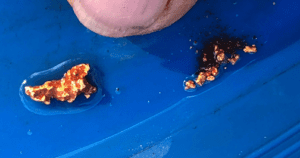
“This area is rich in gold,” Fisher told Harris of the area around Wood and Ransom’s Bridge. “A lot of gold has been found over the years.” And he predicts that there’s still a lot of gold to be found. It just isn’t an easy process. “It’s in the clay, and you really have to work hard to get the gold separated from the clay,” he said.
As the story goes, peddlers traveling through the area near Wood in the backwoods of what is now Franklin County would stop in at John Portis’s place to spend the night, sort of a modern-day bed and breakfast. One peddler noticed that the “twinkling mud” Portis had put between the logs of his cabin to keep it airtight, Fisher said.
He researched mining journals and old newspapers to learn more about the history of the Portis Gold Mine. He knows that the mining process involved using running water through troughs to separate the mineral from the clay. The clay slurry produced was then washed away, leaving the gold behind. This was a difficult way to extract gold, he said, so prospectors were eager to head West, where they had heard gold was much easier to find. The town of Wood, located in northeastern corner of Franklin County, used to have its own post office and railroad station, as well as a general store, Fisher said. Now, however, it’s just a crossroads. The buildings that housed the post office and the train station remain, but that’s about it, Fisher said. He hopes that increased tourism to Gold Run Branch Goldmine will bring a little “shine” back to the area.
In his research about the area Fisher has learned that notables of the time visited Wood – Thomas Edison and Mark Twain, for example. He also said he discovered that the very first performance in North Carolina of the Ringling Bros. and Barnum & Bailey Circus was at Portis Gold Mine.
Perhaps the most unusual discovery, however, was one that Fisher and his son made while walking their property. They noticed timbers sticking out of the ground in a very wet, swampy area near a creek. Fisher thought it may the remains of an old stamp mill, which were often found near gold mining sites. His son thought it may be the entrance to a long-forgotten mine shaft. They finally got the chance to investigate in October of 2019, when the area was finally dry enough to get to the timbers.
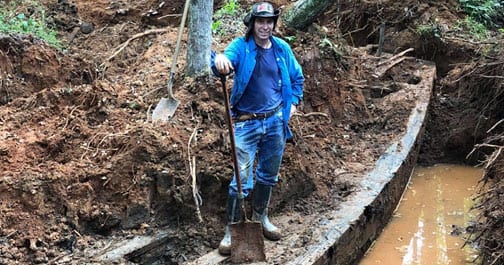 To their surprise, they found a ship – a bucket line dredge, to be exact. This particular dredge, although buried in mud and sediment now, was used for several years, Fisher said, “until the gold got thin, and then they just stopped using it.” The mining journals Fisher researched noted that the dredge was built in New York City and then disassembled and put in pieces on a train for delivery to Portis Gold Mine. It is 94 feet long and 32 feet wide, and has a 7-foot-deep hull.
To their surprise, they found a ship – a bucket line dredge, to be exact. This particular dredge, although buried in mud and sediment now, was used for several years, Fisher said, “until the gold got thin, and then they just stopped using it.” The mining journals Fisher researched noted that the dredge was built in New York City and then disassembled and put in pieces on a train for delivery to Portis Gold Mine. It is 94 feet long and 32 feet wide, and has a 7-foot-deep hull.
“The crazy thing is the paint is still on the wood,” Fisher said, adding that the color is barn red. Some glass is still intact and the hinges are still on the doors. His best guess is that the roof split in two and the dredge slowly sank and was buried in the sediment that flowed into the valley where it is currently situated. The plan is to rebuild it so visitors can have an idea of what it was like in its heyday.
Fisher wants to mine the mounds of sediment in and around the dredge, in hopes of finding some gold there. “All the water runs through the ship,” he said, which makes it like “a huge gold pan.” Fisher explained that the main purpose of dredging was to separate the smaller pieces of gold from the clay, which meant that the larger “klunkers” would be discarded with the slurry. He expects to find some klunkers as their prospecting continues.
Fisher found a story from 1911 in Henderson’s Gold Leaf newspaper that estimated the Portis Gold Mine had more than $1 billion in gold. Fisher projects that, with the price of gold hovering at around $1,700 per ounce today, today’s estimate could be double.
Back in the 1980’s, when gold prices were low, so was interest in land that had gold mines on it. Fisher bought his property after it had passed through several tree companies’ ownership. One reason he and his son chose the particular two tracts was because there is a small branch that runs through a little valley. It is a perfect spot for sediment to accumulate. Sediment that may contain something a little shinier than the prevalent orange clay. “We knew there was gold there,” he said, adding that he got a fair amount of kidding at first for buying what amounted to a swampy flood plain.
“We still get gold on a daily basis,” Fisher said. But one byproduct of this gold-mining process is stains – on clothing, on hands, on everything. “It looks like … a weird fingernail polish.”






